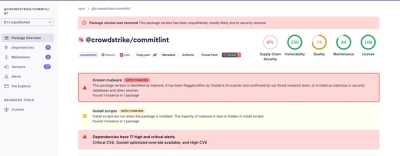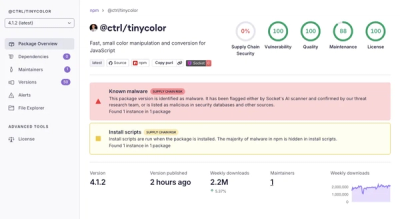socket-controllers






Use class-based controllers to handle websocket events.
Helps to organize your code using websockets in classes.
Installation
-
Install module:
npm install socket-controllers --save
-
reflect-metadata shim is required:
npm install reflect-metadata --save
and make sure to import it in a global place, like app.ts:
import "reflect-metadata";
-
ES6 features are used, if you are using old version of node.js you may need to install
es6-shim:
npm install es6-shim --save
and import it in a global place like app.ts:
import "es6-shim";
-
Optionally you can install socket.io typings:
typings install dt~socket.io --save --global
Example of usage
-
Create a file MessageController.ts
import {OnConnect, SocketController, ConnectedSocket, OnDisconnect, MessageBody, OnMessage} from "socket-controllers";
@SocketController()
export class MessageController {
@OnConnect()
connection(@ConnectedSocket() socket: any) {
console.log("client connected");
}
@OnDisconnect()
disconnect(@ConnectedSocket() socket: any) {
console.log("client disconnected");
}
@OnMessage("save")
save(@ConnectedSocket() socket: any, @MessageBody() message: any) {
console.log("received message:", message);
console.log("setting id to the message and sending it back to the client");
message.id = 1;
socket.emit("message_saved", message);
}
}
-
Create a file app.ts
import "es6-shim";
import "reflect-metadata";
import {createSocketServer} from "socket-controllers";
import "./MessageController";
createSocketServer(3001);
-
Now you can send save websocket message using webosocket-client.
More usage examples
Run code on socket client connect / disconnect
Controller action marked with @OnConnect() decorator is called once new client connected.
Controller action marked with @OnDisconnect() decorator is called once client disconnected.
import {SocketController, OnConnect, OnDisconnect} from "socket-controllers";
@SocketController()
export class MessageController {
@OnConnect()
save() {
console.log("client connected");
}
@OnDisconnect()
save() {
console.log("client disconnected");
}
}
@ConnectedSocket() decorator
To get connected socket instance you need to use @ConnectedSocket() decorator.
import {SocketController, OnMessage, ConnectedSocket} from "socket-controllers";
@SocketController()
export class MessageController {
@OnMessage("save")
save(@ConnectedSocket() socket: any) {
socket.emit("save_success");
}
}
@MessageBody() decorator
To get received message body use @MessageBody() decorator:
import {SocketController, OnMessage, MessageBody} from "socket-controllers";
@SocketController()
export class MessageController {
@OnMessage("save")
save(@MessageBody() message: any) {
console.log("received message: ", message);
}
}
If you specify a class type to parameter that is decorated with @MessageBody(),
socket-controllers will use class-transformer to create instance of the given class type with the data received in the message.
To disable this behaviour you need to specify a { useConstructorUtils: false } in SocketControllerOptions when creating a server.
@SocketQueryParam() decorator
To get received query parameter use @SocketQueryParam() decorator.
import {SocketController, OnMessage, MessageBody} from "socket-controllers";
@SocketController()
export class MessageController {
@OnMessage("save")
save(@SocketQueryParam("token") token: string) {
console.log("authorization token from query parameter: ", token);
}
}
Get socket client id using @SocketId() decorator
To get connected client id use @SocketId() decorator.
import {SocketController, OnMessage, MessageBody} from "socket-controllers";
@SocketController()
export class MessageController {
@OnMessage("save")
save(@SocketId() id: string) {
}
}
Get access to using socket.io instance using @SocketIO() decorator
import {SocketController, OnMessage, MessageBody} from "socket-controllers";
@SocketController()
export class MessageController {
@OnMessage("save")
save(@SocketIO() io: any) {
}
}
Send message back to client after method execution
You can use @EmitOnSuccess decorator:
import {SocketController, OnMessage, EmitOnSuccess} from "socket-controllers";
@SocketController()
export class MessageController {
@OnMessage("save")
@EmitOnSuccess("save_successfully")
save() {
}
}
If you return something, it will be returned in the emitted message data:
import {SocketController, OnMessage, EmitOnSuccess} from "socket-controllers";
@SocketController()
export class MessageController {
@OnMessage("save")
@EmitOnSuccess("save_successfully")
save() {
return {
id: 1,
text: "new message"
};
}
}
You can also control what message will be emitted if there is error/exception during execution:
import {SocketController, OnMessage, EmitOnSuccess, EmitOnFail} from "socket-controllers";
@SocketController()
export class MessageController {
@OnMessage("save")
@EmitOnSuccess("save_successfully")
@EmitOnFail("save_error")
save() {
if (1 === 1) {
throw new Error("One is equal to one! Fatal error!");
}
return {
id: 1,
text: "new message"
};
}
}
In this case save_error message will be sent to the client with One is equal to one! Fatal error! error message.
Additionally, you can also control what message will be emitted for specific error conditions:
import {SocketController, OnMessage, EmitOnSuccess, EmitOnFail, EmitOnFailFor} from "socket-controllers";
@SocketController()
export class MessageController {
@OnMessage("save")
@EmitOnSuccess("save_successfully")
@EmitOnFailFor("id_not_found", () => NotFoundException)
@EmitOnFail("save_error")
save(id: string) {
if (id <= 0) {
throw new NotFoundException("The provided id could not be found!");
} else {
throw new Error("Could not save id!");
}
return {
id: 1,
text: "new message"
};
}
}
export class NotFoundException {
constructor(message?: string);
}
In this case id_not_found message will be sent to the client with The provided id could not be found! error message when the NotFoundException was thrown.
Otherwise the client will receieve save_error with Could not save id! error message.
Note: If you want to use @EmitOnFailFor() your thrown exceptions cannot inherit from the Error class, unless you use this workaround. Not inheriting from the Error class will also let you
differentiate between JavaScript runtime errors and your Application Exceptions.
Sometimes you may want to not emit success/error message if returned result is null or undefined.
In such cases you can use @SkipEmitOnEmptyResult() decorator.
import {SocketController, OnMessage, EmitOnSuccess, EmitOnFail, SkipEmitOnEmptyResult} from "socket-controllers";
@SocketController()
export class MessageController {
@OnMessage("get")
@EmitOnSuccess("get_success")
@SkipEmitOnEmptyResult()
get(): Promise<Message[]> {
return this.messageRepository.findAll();
}
}
In this case if findAll will return undefined, get_success message will not be emitted.
If findAll will return array of messages, they will be emitted back to the client in the get_success message.
This example also demonstrates Promises support.
If promise returned by controller action, message will be emitted only after promise will be resolved.
Using exist server instead of creating a new one
If you need to create and configure socket.io server manually,
you can use useSocketServer instead of createSocketServer function.
Here is example of creating socket.io server and configuring it with express:
import "reflect-metadata";
import {useSocketServer} from "socket-controllers";
const app = require("express")();
const server = require("http").Server(app);
const io = require("socket.io")(server);
server.listen(3001);
app.get("/", function (req: any, res: any) {
res.send("hello express");
});
io.use((socket: any, next: Function) => {
console.log("Custom middleware");
next();
});
useSocketServer(io);
Load all controllers from the given directory
You can load all controllers in once from specific directories, by specifying array of directories via options in
createSocketServer or useSocketServer:
import "reflect-metadata";
import {createSocketServer, loadControllers} from "socket-controllers";
createSocketServer(3000, {
controllers: [__dirname + "/controllers/*.js"]
});
Using socket.io namespaces
To listen to messages only of the specific namespace you can mark a controller with namespace:
@SocketController("/messages")
export class MessageController {
}
Using middlewares
Middlewares are the functions passed to the socketIo.use method.
Middlewares allows you to define a logic that will be executed each time client connected to the server.
To create your middlewares use @Middleware decorator:
import {Middleware, MiddlewareInterface} from "socket-controllers";
@Middleware()
export class CompressionMiddleware implements MiddlewareInterface {
use(socket: any, next: ((err?: any) => any)) {
console.log("do something, for example get authorization token and check authorization");
next();
}
}
Don't forget to load your controllers and middlewares
Controllers and middlewares should be loaded globally, before app bootstrap:
import "reflect-metadata";
import {createSocketServer} from "socket-controllers";
import "./MessageController";
import "./MyMiddleware";
let io = createSocketServer(3000);
Also you can load them from directories. Also you can use glob patterns:
import "reflect-metadata";
import {createSocketServer, loadControllers} from "socket-controllers";
let io = createSocketServer(3000, {
controllers: [__dirname + "/controllers/**/*.js"],
middlewareDirs: [__dirname + "/middlewares/**/*.js"]
});
Using DI container
socket-controllers supports a DI container out of the box. You can inject your services into your controllers and
middlewares. Container must be setup during application bootstrap.
Here is example how to integrate socket-controllers with typedi:
import "reflect-metadata";
import {createSocketServer, useContainer} from "socket-controllers";
import {Container} from "typedi";
useContainer(Container);
let io = createSocketServer(3000, {
controllers: [__dirname + "/controllers/*.js"],
middlewareDirs: [__dirname + "/middlewares/*.js"]
});
That's it, now you can inject your services into your controllers:
@SocketController()
export class MessageController {
constructor(private messageRepository: MessageRepository) {
}
}
Decorators Reference
@SocketController(namespace?: string) | Registers a class to be a socket controller that can listen to websocket events and respond to them. |
@OnMessage(messageName: string) | Registers controller's action to be executed when socket receives message with given name. |
@OnConnect() | Registers controller's action to be executed when client connects to the socket. |
@OnDisconnect() | Registers controller's action to be executed when client disconnects from the socket. |
@ConnectedSocket() | Injects connected client's socket object to the controller action. |
@SocketIO() | Injects socket.io object that initialized a connection. |
@MessageBody() | Injects received message body. |
@SocketQueryParam(paramName: string) | Injects query parameter from the received socket request. |
@SocketId() | Injects socket id from the received request. |
@SocketRequest() | Injects request object received by socket. |
@SocketRooms() | Injects rooms of the connected socket client. |
@Middleware() | Registers a new middleware to be registered in the socket.io. |
@EmitOnSuccess(messageName: string) | If this decorator is set then after controller action will emit message with the given name after action execution. It will emit message only if controller succeed without errors. If result is a Promise then it will wait until promise is resolved and emit a message. |
@EmitOnFail(messageName: string) | If this decorator is set then after controller action will emit message with the given name after action execution. It will emit message only if controller throw an exception. If result is a Promise then it will wait until promise throw an error and emit a message. |
@EmitOnFailFor(messageName: string, errorType: () => ObjectType) | If this decorator is set then after controller action will emit message with the given name after action execution. It will emit message only if controller throw an exception of the specified type. If result is a Promise then it will wait until promise throw an error and emit a message. |
@SkipEmitOnEmptyResult() | Used in conjunction with @EmitOnSuccess and @EmitOnFail decorators. If result returned by controller action is null or undefined then messages will not be emitted by @EmitOnSuccess or @EmitOnFail decorators. |
Samples
Take a look on samples in ./sample for more examples
of usage.
Related projects
- If you are interested to create controller-based express or koa server use routing-controllers module.
- If you need to use dependency injection in use typedi module.



